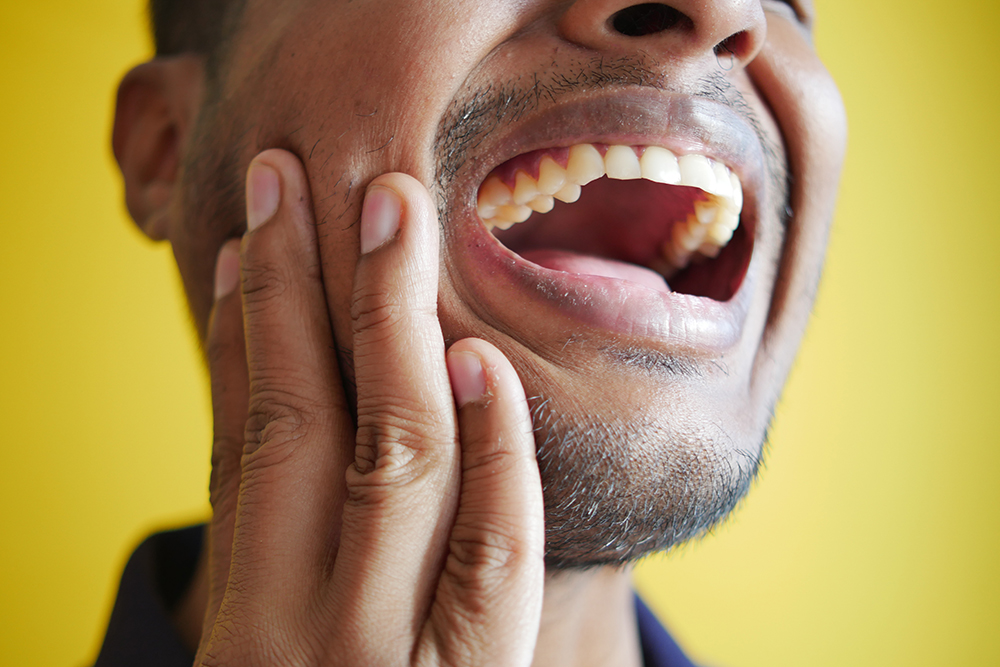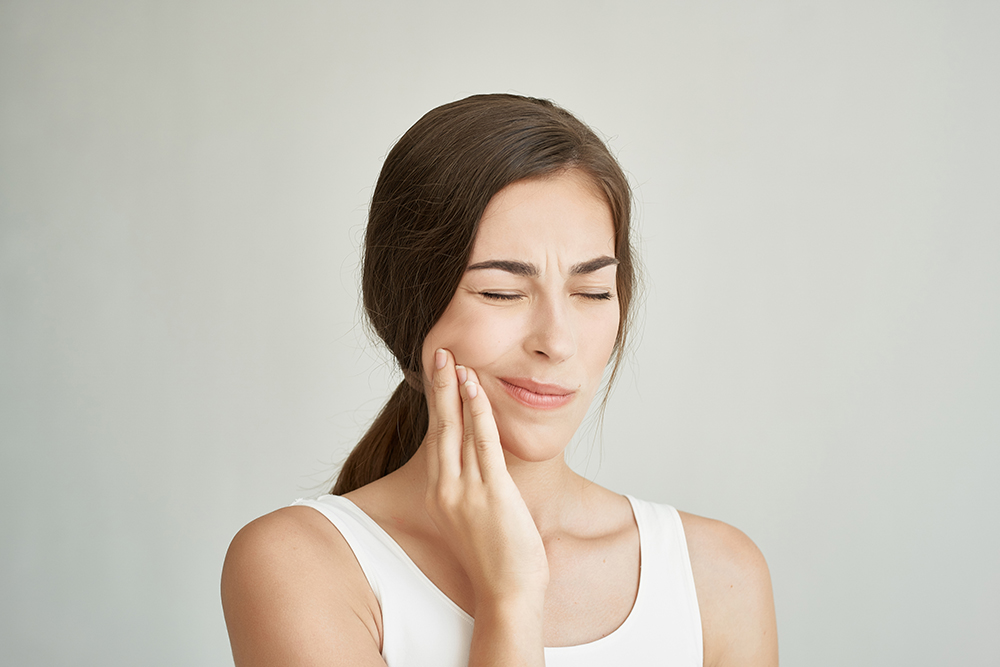Contents
The temporomandibular joint (TMJ) is the part of your jaw that connects your jawbone to the rest of your skull and acts almost like a sliding hinge to help your mouth open and close smoothly. When that joint can’t function properly, you may experience TMJ pain, which is a pain in the hinge of your jaw that can affect one or both sides of your mouth. A TMJ disorder may make it difficult for you to chew or open or close your mouth without pain.
Dealing with TMJ pain can be frustrating, but it’s not uncommon, since between 5% and 12% of the general population experiences some kind of TMJ disorder. However, there are treatments you can do to help decrease pain and popping in your jaw from a TMJ disorder, so let’s explore some PT exercises that can decrease TMJ pain.
Best exercises for TMJ disorder
When you think of exercise, you probably imagine running or lifting weights. TMJ pain exercises are a little different, but with time and effort, they can make a significant improvement to your TMJ pain. These exercises can easily be done while reading or scrolling the internet and should be repeated several times a day:
- Resist mouth closing — For this exercise, place your thumbs under your chin and your index fingers between your chin and your mouth’s ridge. Your mouth should be open at this time. Using your fingers and thumbs, gently place downward pressure on your chin as you close your mouth. Repeat several times.
- Resist mouth opening — For this exercise, place two fingers under your chin. Your mouth should be closed at this time. While holding gentle pressure on your chin with your fingers, slowly open your mouth and hold this position for three to six seconds before slowly closing your mouth. Repeat several times.
- Tongue lifts — For this exercise, move your tongue so it’s touching the roof of your mouth; then open and close your mouth slowly while keeping your tongue connected to the roof of your mouth. Repeat several times.
- Tongue up exercise — For this exercise, close your mouth so that your teeth are touching but not clenched together. Place the tip of your tongue directly behind your upper front teeth and guide it backward toward your soft palate until you can’t reach any further, but make sure your teeth stay together. Keeping your tongue connected to the roof of your mouth, slowly open your mouth until your tongue starts to disconnect, and hold this position for five seconds before closing your mouth and relaxing. Repeat this exercise for about five minutes up to twice a day.
- Jaw slide side to side — For this exercise, bite down gently on an object that’s about ¼-inch thick, similar to the thickness of two popsicle sticks; then gently move your jaw from side to side. Do this very slowly and repeat several times. As this exercise gets easier over time, you can increase the thickness of the object.
- Jaw slide forward — Just like the exercise above, bite down gently on an object that’s about ¼-inch thick, similar to the thickness of two popsicle sticks; then gently move your jaw forward until your top teeth are in front of your bottom teeth. Repeat several times. As this exercise gets easier over time, you can increase the thickness of the object.
- Goldfish exercise — For this exercise, press your tongue to the roof of your mouth and then place your left index finger on the left hinge of your jaw and your right index finger on your chin. Apply light pressure with both fingers and drop your chin, making sure to keep your tongue connected to the roof of your mouth. Repeat this exercise several times; then switch to the other side of the jaw.
- Chin tucks — For this exercise, you must be standing or sitting with your shoulders back and chest lifted. Bring your head straight back while tucking in your chin, but make sure your head stays straight throughout this motion. Hold for three seconds and repeat several times.
While you may feel some slight soreness in your jaw after doing these exercises, they should not cause you any pain. If you feel pain during the exercises, stop right away, and if the pain lasts beyond a few hours, consult your doctor immediately.
The goal with your TMJ exercises is to experience gradual improvement. It may take time before you notice a positive effect, but you should gradually see improvement in your jaw alignment little by little.
Causes of TMJ disorder
It can be difficult to figure out the exact cause of your TMJ disorder since there are a number of reasons why you may experience TMJ pain. Here are a few possible causes of that pain:
- Long-term clenching or grinding of the teeth can strain the jaw muscles.
- Various types of arthritis may target the jaw joint.
- Jaw misalignment can be due to genetic factors.
- The jaw joint is damaged by a blow or other injury.
- The disc in the jaw has moved out of alignment or eroded.
- The cartilage in the jaw has been damaged by wear and tear or disease.
- Connective tissue diseases can affect the tissue in the jaw.
Most of the time, TMJ pain is temporary and can be decreased with at-home exercises or other noninvasive treatments, but if your TMJ disorder is severe, you may be recommended surgery as a last resort.
Symptoms of TMJ disorder
If you have TMJ disorder, there are a number of symptoms you may experience, and these can range from mild to severe. Here are some of the most common TMJ disorder symptoms that you may have:
- Pain or tenderness in the jaw.
- Sore jaw, especially in the hinge area.
- Pain in one or both of the temporomandibular joints (hinge of jaw).
- Aching pain in and around the ear.
- Ringing in the ears or ear pain.
- A popping or clicking sound when the jaw is opened or closed.
- Difficulty or pain while chewing.
- Aching pain in the face area.
- Locking of the jaw joint, which makes it difficult to open or close the mouth.
- Muscle tension in the head or neck.
- Headaches and migraines.
- Head, shoulder or neck pain.
- Tightness in the shoulders.
- Vertigo.
- Ground-down or worn teeth.
- Cold-sensitive teeth.
- Pain or discomfort behind the eyes.
- Tingling in the fingers.
If you have a TMJ disorder, you may experience some or all of these symptoms. For an official diagnosis, talk with your dentist or a doctor.
When to see a medical professional for TMJ disorder
If you’re wondering whether your TMJ pain is severe enough that at-home treatments won’t cut it, there are a few symptoms to look out for. You should seek medical attention if you are experiencing persistent pain or tenderness in your jaw or if you can’t open or close your jaw completely. Your doctor, dentist or a TMJ specialist can help get you the right diagnosis and proper treatment.
Physical therapy can be a highly effective treatment method for TMJ disorders, and at Lattimore Physical Therapy, our physical therapists are trained in exercises, stretches and various physical therapy techniques to help people with TMJ pain.
You don’t have to live with TMJ pain forever. Our physical therapists at Lattimore PT can help correct jaw misalignment and help decrease TMJ pain and discomfort. If you’re ready to take control of your jaw pain, contact our team today for more information or to schedule an initial appointment.



